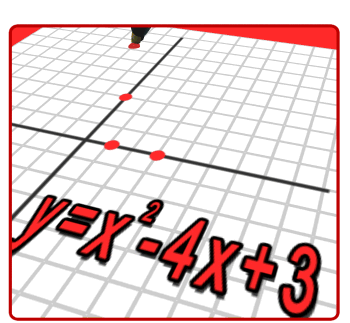Algebra, part 3- factoring, quadratic equations, exponent laws
This series of lessons is designed to help you learn, or review, the fundamentals of algebra. In this lesson we move on to factoring and simplifying expressions, solving quads and dealing with exponents.
Algebra isn't as scary as some people tend to think. Up to know we've dealt with super-basic algebra. What's coming up next is a bit more challenging, but like all math, practice will make this as easy as  .
.
Let's begin by simplifying and factoring expressions:
Take a look at:  . Are you freaking out yet? Ok, we won't deal with that one, but in short, this sort of thing isn't such a big monster. There are ways, nice and easy ways, of making this sort of beast become a cute little poodle. Metaphorically speaking.
. Are you freaking out yet? Ok, we won't deal with that one, but in short, this sort of thing isn't such a big monster. There are ways, nice and easy ways, of making this sort of beast become a cute little poodle. Metaphorically speaking.
| Simplification means just that- simplifying huge expressions into nicer ones. Note that this isn't solving equations (clearly, since there's no = sign, not even a < or > sign), so you can't just divide everything by something or subtract something else to make the thing you're looking at look nicer. What can we do? One of the basic things we can do is to collect like terms. Illustrating this using a simple example: |  |
The more important thing though is factoring. Like my math teacher used to say, if you're stuck on an ugly problem and feel like saying the F word, add a "tor" to the end of it and you get "factor". (If you don't get this joke, ask me later). Another simple illustration with an example:  . Yeah, since the
. Yeah, since the  is common, we pulled it out, and got a much nicer thing in exchange. That's the basis of factoring- find common elements and pull them out.
is common, we pulled it out, and got a much nicer thing in exchange. That's the basis of factoring- find common elements and pull them out.
An immediate and important thing to do is learn how to factor quadratics. Quadratic expressions are expressions with 1 variable, where the variable is raised to the power of 2.  is a good example. Note that:
is a good example. Note that:  . Not so scary now, is it? Practicing will make you expert at factoring this and other expressions.
. Not so scary now, is it? Practicing will make you expert at factoring this and other expressions.
Before we go on, a few nice tricks:
Some expressions require you to expand, the opposite of factor. There are a few simple expansion tricks worth remembering:
1. 
2. 
3. 
These should help get you through the day.
| And now, let's move on to quadratic equations %{font-family:verdana;font-size:13px;color:blue}*Quadratic equations*%always look like this: |  |
1. Factoring: Remember this? We can sometimes turn a nasty  into a nice
into a nice  situation. Once there, it's clear that either
situation. Once there, it's clear that either  or
or  . These you can solve easily. Note that you'll get 2 possible solutions- that's ok, that's what should happen most often.
. These you can solve easily. Note that you'll get 2 possible solutions- that's ok, that's what should happen most often.
2. The quadratic formula is the second way of solving quads. It always works, no matter what, but it can give you nasty results and it's not as fast. The formula goes like this:  . Note that the +/- thing means you have to do it twice, once with a + and once with a - . This will again give you 2 answers. We'll come back to this formula later on in life to understand complex numbers.
. Note that the +/- thing means you have to do it twice, once with a + and once with a - . This will again give you 2 answers. We'll come back to this formula later on in life to understand complex numbers.
This could be worse, right? Say,  . Well, actually, this expression is equivalent to
. Well, actually, this expression is equivalent to  , but to get there you need to look at exponents and their laws.
, but to get there you need to look at exponents and their laws.
%{font-family:verdana;color:BLUE; font-size:16px}*Exponent laws- even exponents can be made simple%*
Yes, believe it or not, it's true. Here is a short, exhaustive list of the rules you can use to simplify exponents:
bq. a. Now you can quickly see how  .
.
| So, with everything we learned in this lesson, we can clean up some large, messy expressions into nice, simple ones, and then solve them if they're in equations. See, math isn't such an awful thing after all. Next time, we'll get into algebra that has to do with number theory, with some stuff about primes, complex numbers and more. |  |

No comments:
Post a Comment